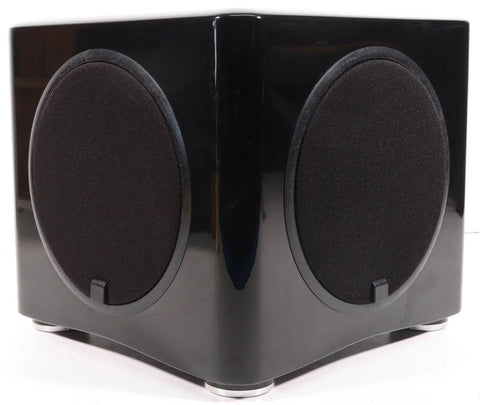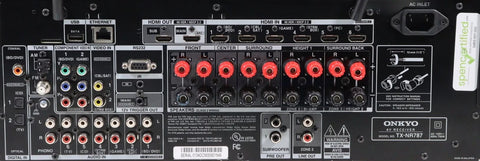We are unable to reply to comments, so please message us directly if you have a specific question regarding products, shipping costs, etc. Our office number is (480) 207-1511. Our email is hello@spencertified.com. You can also message us on Facebook. Commonly asked questions and answers can be found on our FAQs page here.

STEREO GEAR JARGON | WORDS TO KNOW BEFORE BUYING A RECEIVER OR AN AMPLIFIER
WORDS, TERMS, AND FEATURES THAT YOU SHOULD BECOME FAMILIAR WITH BEFORE BUILDING YOUR HOME AUDIO SYSTEM.
So you’ve decided to start building or expanding your home audio system - awesome! You get comfortable, pull up your browser, begin to search for equipment…and aren’t sure what to look for. There’s a lot of helpful information out there, but it’s scattered and filled with words you’re not too familiar with - or have never even heard before.
Well, we’re here to help! This guide will take you through the basic terms you should know before purchasing stereo gear.
Pro tip: If you’re looking for a certain term, you can use CTRL+F to quickly search this article for it.
RECEIVER

A stereo receiver is a component that receives audio and video signals from different sources (like DVD players, cassette decks, or turntables) and routes them to audio outputs (like speakers) and video outputs (like TVs or monitors). In other words, a receiver is an amplifier with an AM/FM tuner built in. It is your home base and the first place to start when building a home audio system.
Each receiver will have different hookup options (connections for components such as VCRs, CD players, and TVs), so be sure to know what you want to have in your home audio system before buying a receiver.
AMPLIFIER
An amplifier provides power for your speakers. Basically, it amplifies low-power electronic audio signals to a level high enough to drive loudspeakers or headphones. It’s essential to have when designing your home stereo system. An amplifier is built into the receiver.
PREAMPLIFIER
A preamplifier - or preamp - is the component that comes before an amplifier in an audio signal chain, so usually it’s the first piece of equipment that comes after your playback device (like a turntable or CD player). In a typical system, after that would come your power amplifier and then your speakers.
It strengthens low-level signals and has useful features and functions like gain control, equalization, and impedance matching.
INTEGRATED AMPLIFIER
An integrated amplifier is a standard receiver without an AM/FM tuner. The tuner is removed because, for the purpose of sound quality, the fewer components in one device the better.
POWER AMPLIFIER

A power amplifier is designed to convert low-power signals into high-power ones. They are typically used to drive loudspeakers and equipment that has higher wattage and thus need more power than a typical amplifier can supply.
TUNER
A stereo tuner is a simple way to listen to AM/FM radio. If you connect one of these to your home audio system, you will receive high-quality signals for all of your favorite AM or FM stations.
SUBWOOFER


A subwoofer is a type of loudspeaker that is dedicated to reproducing low audio frequencies. In other words, subwoofers are all about the bass - that low, heart-pounding throb that will suck you right into the music.
CHANNELS
The number of channels (3.1, 5.2, 7.1, 9.1, etc.) refers to the number of speakers that a receiver is capable of powering. For example, a 5.1-channel system powers 5 standard speakers and 1 subwoofer while a 7.2-channel system powers 7 standard speakers and 2 powered subwoofers.
TUBES
Vacuum tubes are the key component in many vintage systems. Used in radios, preamps, and other electronic devices, they transmit and receive radio signals -basically, they amplify and strengthen signals. Because they can create a warmer, richer tone, tube systems hold a special place in the hearts of most audiophiles.
HDMI

HDMI stands for High-Definition Multimedia Interface; it’s a standard for transmitting digital audio/video signals from one source (like a computer or gaming system) to another (like a TV, projector, or monitor). When it comes to amplifiers, having HDMI ports offers more flexibility in hooking the system up to the rest of your components, particularly newer components.
SPEAKER WATTS AND OHMS
On the back of most speakers is an ohm and wattage rating. You want the ohms to match the system requirements, and the wattage of the receiver should be a little bit lower than what the speaker can handle. A google search of the stereo model and the word “watts” should quickly tell you where your system rates.
AM, FM, AND XM RADIO
Built-in radio is a feature most receivers will have. If you listen to XM, AM, or FM radio, be sure the receiver is compatible. Receivers will have a built-in AM/FM tuner for receiving local channels. XM radio is far less common and often requires a special antenna. You can also get an external tuner if there isn’t one built-in.
OPTICAL AUDIO

Digital optical audio is the best option for an audio cable. Basically, an optical audio system uses fiber optic cables and laser light to transmit digital audio signals between devices, making it higher quality compared to other cabling standards.
Most TVs have an optical digital audio output. If you get an optical digital audio compatible receiver, you can connect a cable from the TV to the receiver and make it so any audio that goes to your TV speakers will also go to the receiver.
PHONO
A phono connection on the rear panel of a receiver means that you can connect your turntable to it. Many, but not all, receivers will have a phono connection, so be sure to look for one if you want to hook up a turntable to your system.
BRANDS
There are tons of brands out there that you are likely to run into: Sony, Denon, Pioneer, Marantz, NAD, Technics, Realistic, Onkyo, JVC, Integra, Harman/Kardon, Kenwood, Yamaha, and more.
Denon, Pioneer, Yamaha, and Technics tend to make the most reliable and best-sounding equipment. Sony and Onkyo are good choices as well, particularly if you look at their older systems.
Pro tip: Avoid the brand Pyle. Their products are low-quality and designed to be replaced.
REFURBISHED

Refurbished means that the item was previously owned and used, and it has since been inspected, tested, and restored to a marketable condition.
So why would you want to buy refurbished instead of new? Many reasons, actually. As you probably already know, most modern equipment - from appliances to TVs to audio components - is just not built to last. In fact, vintage models, despite their age, will probably outlive you when given proper service and care. Plus, purchasing used and refurbished equipment is better for the environment, guarantees higher quality, offers a wider range of options, and is more cost-effective in the long run.
IN SUMMARY
Stereo gear jargon can be overwhelming to read and listen to when you’re first delving into the world of audio and video equipment, so we hope this breakdown of terms and features helps!
Receivers, amplifiers, and audio centers can be difficult to find these days, especially older vintage models since they are no longer manufactured. If you are wanting something that is vintage, high-quality, and guaranteed to function like new, then SpenCertified is the way to go: we specialize in vintage equipment and have a wide range of systems available.
You can check out all of our home audio amplifiers here: https://spencertified.com/collections/home-audio-amplifiers



Leave a comment